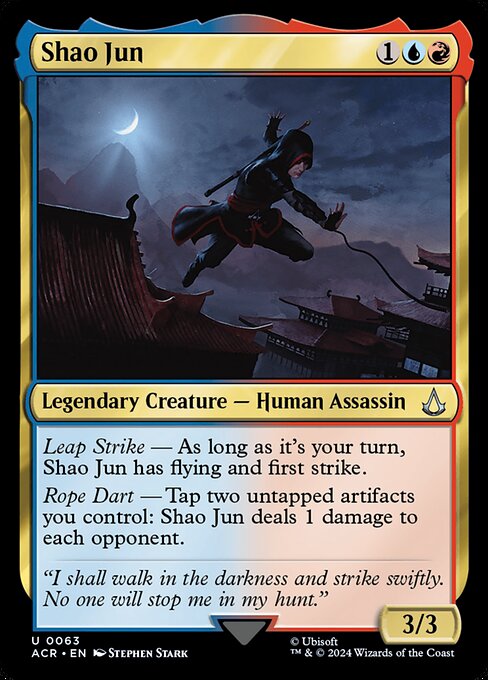
Image courtesy of Scryfall.com
nostalgia as the quiet engine behind deep MTG connections
There’s a certain magic in memory that white-knuckles you into a table full of friends you’ve known for years and strangers you’re just beginning to know. Nostalgia isn’t just sentiment—it’s a shared language that unlocks a comfort level in every turn and every trade that newcomers sometimes spend years building. With Shao Jun, that language gets a delightful Si-Rai upgrade: a blue-red cross between high-velocity tempo and a ninja’s precise, surgical strike. The cross-media tie-in to Assassin's Creed invites players who loved that game’s lore to discover a new channel for the same feeling—snappy decisions, hidden information, and the thrill of a well-timed finisher. 🧙🔥💎⚔️
Shao Jun: a card built for memory-driven play
At first glance, Shao Jun is a nimble 3/3 for 3 mana, a Legendary Creature — Human Assassin whose color identity blends blue and red. The mana cost, {1}{U}{R}, immediately signals a deck built for speed and improvisation. The card’s two core abilities—Leap Strike and Rope Dart—are not decorative verbs; they are storytelling devices that echo classic MTG tempo play and the flavor of an escalated hunt. During your turn, Shao Jun gains flying and first strike, letting you threaten air and earth in the same breath. Then Rope Dart reacts to your artifact ecosystem: tap two untapped artifacts you control, and Shao Jun deals 1 damage to each opponent. It’s a clever reminder that in MTG, strategy often threads through what you’ve kept available on the battlefield—your tools, your tempo, and your patience. ⚔️
"I shall walk in the darkness and strike swiftly. No one will stop me in my hunt."
This flavor text narrows its focus to a timeless truth—ninja fingers on a clock, always hunting the moment when risk and opportunity align. Shao Jun’s design isn’t about brute force; it’s about tempo and setup: you queue up counterplay, you present a threat, and you finish while your opponent is still untangling their own plans. The result is a memory that feels earned: a table remembers that one turn when you tapped two artifacts, pushed Shao Jun through the air, and watched an opponent’s plans crumble to a precise, gleaming strike. 🧙🔥🎨
A crossover card that taps into Universes Beyond-loving nostalgia
Assassin's Creed doesn’t just bring a character into MTG; it breathes a narrative that many players have loved across two different worlds. Shao Jun’s set, AC R, sits inside a draft innovation framework, a nod to how Universes Beyond expands the conversation beyond traditional borders. The card’s rarity—uncommon—makes it accessible enough to pilot in Commander, Modern, or Legacy while still feeling like a special pickup for fans who caught the crossover in its heyday. The artwork by Stephen Stark adds an atmospheric line to the character—every shadow and glint on the art becomes a talking point at the table, especially when you’ve got a table full of longtime play partners who know the lore as well as you do. The black-border frame and modern text box remind us that nostalgia can be forward-looking, knitting old vibes into new formats. 🧩
Practical deck ideas: weaving nostalgia into a Shao Jun shell
- Tempo with a twist: Lean into the Leap Strike aspect to surprise opponents who expect you to stay on the ground. A blue-red shell can rhythmically push Shao Jun in and out of combat, using cheap cantrips to refill your options and keep pressure up.
- Artifact economy: Rope Dart rewards a deck that reliably taps artifacts—think cheap rocks or evasive accelerants—to unload damage on a crowded board. The more artifacts you control, the more danger you present to opposing players' life totals.
- Color-coordinated aggression: The red spark and blue precision pair well with counterplay and tempo removal. You’re not just smashing faces; you’re timing your strikes with surgical care, seizing the momentum as the table rotates through threats and answers.
- Commander-friendly design: With Shao Jun’s evergreen synergy in formats like Commander, you can craft a pod-friendly strategy that leans on artifact support, evasive lines, and incremental damage. The nostalgia-flavored aura makes it a memorable commander-night card—one you’ll bring up in storytelling and card-collecting circles alike.
Collectability, art, and value in the nostalgia loop
The card’s aura—uncommon rarity with foil and non-foil finishes—puts it into a sweet spot for collectors who crave both playability and display value. The price point, often hovering around a few pennies to a few dimes in USD for non-foil versions, makes Shao Jun an approachable centerpiece for a crossover-themed deck or a memorable addition to a game-night binder. The illustrated style by Stephen Stark complements the cross-medium vibe, inviting fans to admire the artistry while debating which weave of blue and red best suits their playstyle. It’s a card that invites conversation—about lore, about design decisions, and about how a single turn can squeeze more storytelling into a single game than a novel's worth of pages. 🎨⚔️
A small handoff to play and display in the real world
Beyond the table, nostalgia can bridge the gap between MTG and everyday life. Collectors often seek items that echo the era or the crossover they love, from playmats and sleeves to display cases and phone accessories. If you’re chasing a way to carry the nostalgia with you, consider pairing your Shao Jun moments with a sleek, protective accessory—like the polycarbonate card holder with MagSafe—so your prized cards stay pristine as you travel to games, local tournaments, or casual meetups. It’s a perfect blend of form and function for the modern MTG enthusiast who wants their love for crossovers to travel with them. For easy access and reliable protection, you can check the product here: Polycarbonate Card Holder Phone Case with MagSafe. 🧭